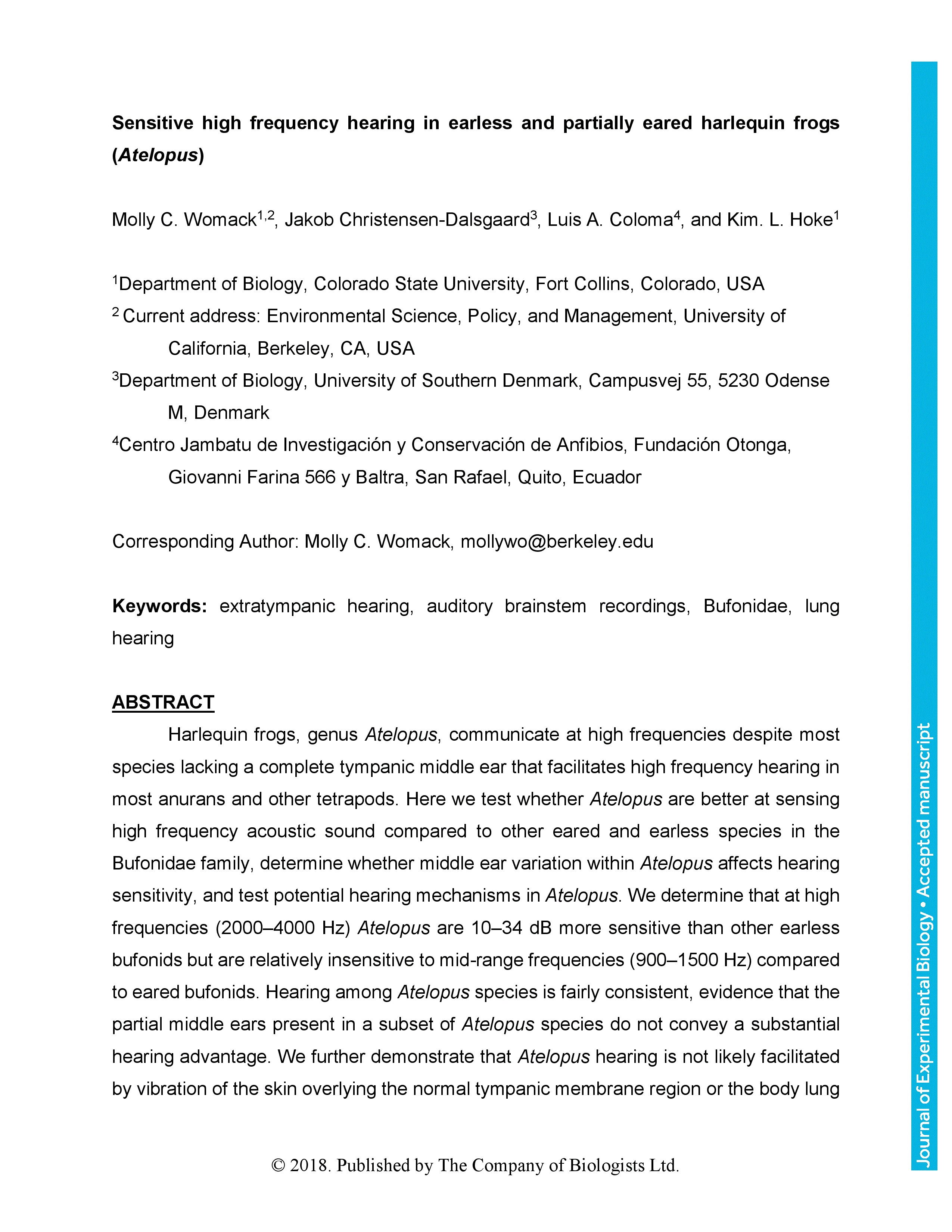Harlequin frogs, genus Atelopus, communicate at high frequencies despite most species lacking a complete tympanic middle ear that facilitates high frequency hearing in most anurans and other tetrapods. Here we test whether Atelopus are better at sensing high frequency acoustic sound compared to other eared and earless species in the Bufonidae family, determine whether middle ear variation within Atelopus affects hearing sensitivity, and test potential hearing mechanisms in Atelopus. We determine that at high frequencies (2000–4000 Hz) Atelopus are 10–34 dB more sensitive than other earless bufonids but are relatively insensitive to mid-range frequencies (900–1500 Hz) compared to eared bufonids. Hearing among Atelopus species is fairly consistent, evidence that the partial middle ears present in a subset of Atelopus species do not convey a substantial hearing advantage. We further demonstrate that Atelopus hearing is not likely facilitated by vibration of the skin overlying the normal tympanic membrane region or the body lung wall, leaving the extratympanic hearing pathways in Atelopus enigmatic. Together these results show Atelopus have sensitive high frequency hearing without the aid of a tympanic middle ear and prompt further study of extratympanic hearing mechanisms in anurans.
Sensitive high frequency hearing in earless and partially eared harlequin frogs (Atelopus)
Currently Viewing Accepted Manuscript - Newer Version Available
Molly C. Womack, Jakob Christensen-Dalsgaard, Luis A. Coloma, Kim. L. Hoke; Sensitive high frequency hearing in earless and partially eared harlequin frogs (Atelopus). J Exp Biol 2018; jeb.169664. doi: https://doi.org/10.1242/jeb.169664
Download citation file:
Advertisement
2023 JEB Outstanding Paper Prize shortlist and winner

The JEB Editors are delighted to announce the shortlisted authors for the 2023 JEB Outstanding Paper Prize. Read the winning paper - Tiny spies: mosquito antennae are sensitive sensors for eavesdropping on frog calls - by Hoover Pantoja-Sanchez and Brian Leavell from Ximena Bernal's lab at Purdue University, USA.
JEB Science Communication Workshop for ECRs

If you’re an early-career researcher interested in science communication and are attending the SEB Annual Conference in Prague this summer, come a day early and join the JEB Editors at a sci comm workshop to learn the key writing skills needed to promote your research to a broad audience beyond your peers (1 July at 14.30-17.30). Places are limited to 24 attendees, and applicants should apply through the SEB registration page by 30 April 2024.
Bridging the gap between controlled conditions and natural habitats in understanding behaviour

Novel technologies enable behavioural experiments with non-model species, in naturalistic habitats and with underexplored behaviours. In their Commentary, Scholz and colleagues discuss how to obtain a deeper understanding of the natural ecology and lifestyle of study animals.
Beluga metabolic measures could help save species

To help save animals from extinction, it’s important to understand what each species needs to survive. This led Jason John et al. to measure the metabolic rates of captive belugas to develop a ‘fish calculator’ showing that the whales need to eat ~23 salmon per day.
ECR Workshop on Positive Peer Review

Are you an ECR looking for tips on how to write concise, astute and useful manuscript reviews? If so, join the JEB Editors at a 2-hour JEB-sponsored Workshop on Positive Peer Review at the Canadian Society of Zoologists annual meeting in Moncton on 9 May 2024 at 13.00-15.00. There are 25 spaces for ECRs and selection is first come, first serve. To sign up, check the ECR Workshop box when you register for the CSZ meeting.



